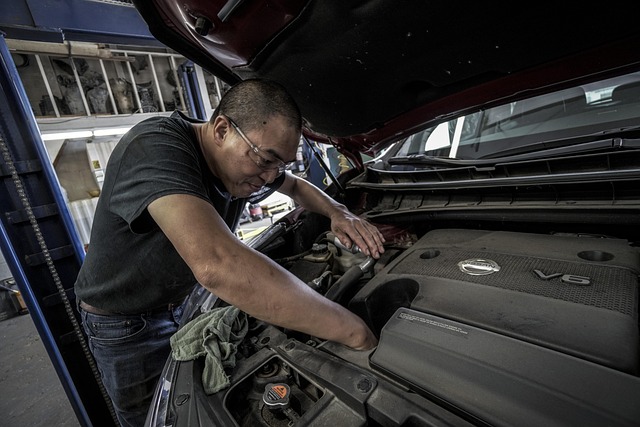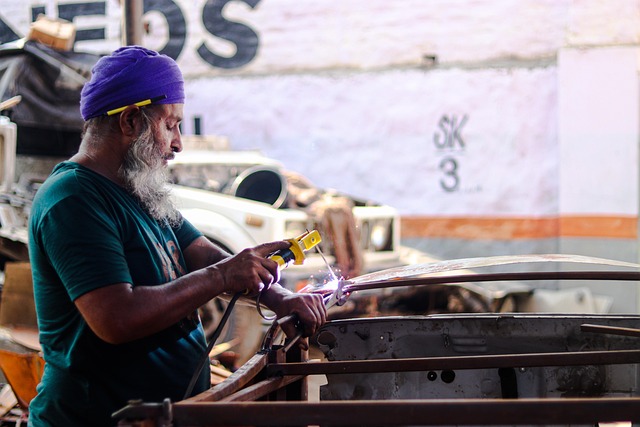Spotting Engine Mount Collision Damage: Visual, Auditory, & Performance Cues
TL;DR: Engine mount collision damage can cause serious auto repair issues, impacting performance and…….
In the intricate world of automotive engineering, ensuring structural integrity and safety is paramount. Among the many critical components that contribute to a vehicle’s overall stability, the engine mount plays a pivotal role. However, a growing concern has emerged: engine mount collision damage. This phenomenon, often subtle yet significant, poses challenges to vehicle performance, safety, and sustainability. In this comprehensive article, we delve into the intricacies of engine mount collision damage, exploring its causes, impacts, global implications, and potential solutions. By the end, readers will gain a profound understanding of this critical issue and its far-reaching effects on the automotive industry.
Definition:
Engine mount collision damage refers to the structural degradation or failure of engine mounts, typically caused by impact events or vibrations exceeding their design tolerances. These mounts are mechanical components that secure the engine to the vehicle’s chassis, allowing for some degree of movement while minimizing transmission of vibrations and forces. When subjected to excessive stress, they can experience cracks, deformations, or complete failure, leading to a cascade of negative effects on the vehicle.
Core Components and Function:
Engine mounts consist of several key elements:
Historical Context:
The concept of engine mounts has evolved significantly since the early days of automobiles. Early designs relied on simple mounting systems, often leading to excessive vibration and noise. As vehicles became more sophisticated, engineers developed advanced mount systems to enhance ride comfort and reduce mechanical interference. However, with increasing engine power, complex workloads, and stricter safety regulations, modern engine mount collision damage has emerged as a critical concern.
Significance:
Engine mount collision damage is not merely a cosmetic issue; it has profound implications for vehicle performance, safety, and longevity:
Engine mount collision damage is not limited to specific regions or vehicle types; it transcends geographical boundaries, affecting cars, trucks, SUVs, and even heavy-duty machinery worldwide. Here’s an overview of its global impact:
| Region | Impact and Observations |
|---|---|
| North America | Known for stringent safety standards, the region has seen a rise in advanced engine mount designs, but collision damage remains a concern, particularly in older vehicles. |
| Europe | Stricter environmental regulations have driven innovation in lightweight materials for engine mounts, reducing vibration and collision-related issues. |
| Asia Pacific | Rapidly growing automotive markets like China and India face challenges with uneven road conditions, leading to increased wear and tear on engine mounts. |
| Middle East & Africa | High temperatures and aggressive driving styles contribute to accelerated degradation of engine mounts, posing unique maintenance challenges. |
Trends Shaping the Landscape:
The economic implications of engine mount collision damage are multifaceted, influencing both the automotive manufacturing sector and the aftermarket services industry.
Market Dynamics:
Investment Patterns:
Economic Impact on Systems:
Engine mount collision damage can have far-reaching economic effects:
The field of engine mount technology has witnessed significant advancements, driven by the need for improved safety, efficiency, and sustainability. Here are some key developments:
Governments and automotive industry regulators play a crucial role in addressing engine mount collision damage through policies and standards:
Key Policies:
Legislative Frameworks:
Despite ongoing advancements and regulatory measures, engine mount collision damage persists as a challenge in the automotive industry:
Proposed Solutions:
Case Study 1: Advanced Materials in Heavy-Duty Trucks
In a pioneering effort, a leading truck manufacturer introduced carbon fiber composite engine mounts in their heavy-duty vehicles. This material transition led to significant improvements:
Lessons Learned:
Case Study 2: Smart Mounts in High-Performance Sports Cars
A sports car manufacturer incorporated smart engine mounts equipped with sensors and actuators to adapt to various driving conditions.
Lessons Learned:
The future of engine mount collision damage mitigation is promising, with several emerging trends shaping its trajectory:
Strategic Considerations:
Engine mount collision damage is a complex challenge that demands continuous attention and innovation from engineers, policymakers, and manufacturers worldwide. As vehicles evolve with advanced powertrains, connectivity, and sustainability goals, so too must the solutions for ensuring their structural integrity and safety. By embracing technological advancements, implementing stringent quality standards, and fostering industry collaboration, the automotive industry can navigate the future landscape of engine mount collision damage, ultimately enhancing vehicle performance, safety, and sustainability.
Q: How often should I check my engine mounts for potential damage?
A: Regularly inspect your vehicle’s engine mounts, especially if you drive in rough conditions or frequently tow heavy loads. Professional mechanics recommend annual checks as part of routine maintenance to ensure early detection of any issues.
Q: Can engine mount collision damage be repaired without replacing the entire mount?
A: In some cases, minor damages like cracks or deformations can be repaired using specialized epoxy compounds or metal repair techniques. However, severe or widespread damage often requires complete replacement for optimal safety and performance.
Q: Are there any DIY solutions for engine mount collision damage?
A: While basic maintenance checks are accessible to vehicle owners, complex repairs involving engine mounts should be left to qualified mechanics due to the potential risks of incorrect installation and safety concerns.
Q: How can I reduce the risk of engine mount collision damage while driving on rough roads?
A: Maintaining proper tire pressure, avoiding sudden sharp turns, and keeping a safe distance from vehicles ahead can help minimize stress on engine mounts. Regularly inspect your vehicle for signs of wear and tear to address issues promptly.
Q: Are there any legal obligations for manufacturers regarding engine mount collision damage?
A: Yes, product liability laws in many countries hold manufacturers accountable for defects that cause injury or property damage. Consumers have rights, and manufacturers must ensure their products, including engine mounts, meet safety standards.

TL;DR: Engine mount collision damage can cause serious auto repair issues, impacting performance and…….

TL;DR:Assessing and repairing engine mount collision damage is vital for vehicle safety and performa…….

After a front-end collision, understanding engine mount collision damage is crucial for safety and v…….

Engine mounts are critical for vehicle stability and performance but can be damaged in accidents or…….

Engine mounts, vital for connecting engines to chassis, are prone to damage in accidents, leading to…….

Engine mounts, critical for vehicle stability, can suffer damage in collisions, posing safety risks…….